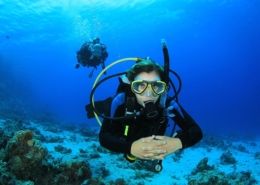Scuba Diving with High Blood Pressure
Article by Nancy Huntington-Grahn
What Is Hypertension?
Hypertension: commonly known as “high blood pressure”, is a chronic medical condition in which the force exerted by the blood against the walls of the arteries remains elevated over time. Blood pressure is measured using two numbers: systolic pressure (the pressure in your arteries when the heart beats) and diastolic pressure (the pressure when the heart is resting in between beats). Hypertension is typically diagnosed when blood pressure readings consistently exceed 130/80 mmHg. Ideally, most providers would agree 120/80 or below is desirable. Both systolic and diastolic numbers are crucial when assessing a person’s overall cardiovascular health and well-being.
Causes and Risk Factors
Hypertension can be categorized as either primary (essential) or secondary. Primary hypertension develops gradually over many years and has no real identifiable cause. Secondary hypertension results from underlying conditions such as kidney disease, hormonal/ endocrine disorders such as Diabetes, or certain medications.
- Genetics: Family history of hypertension increases risk.
- Age: Risk increases as you get older.
- Obesity: Excess body weight can contribute to high blood pressure.
- Diet: High salt intake, low potassium intake, and unhealthy eating habits.
- Physical Inactivity: Sedentary lifestyle.
- Alcohol and Tobacco Use: Excessive consumption can raise blood pressure.
- Chronic Conditions: Diabetes, kidney disease, and sleep apnea.
Symptoms of Hypertension/ Potential complications
Hypertension is often referred to as the “silent killer” because it typically causes no noticeable symptoms until significant damage has occurred. In severe cases, symptoms may include headaches, shortness of breath, nosebleeds, or dizziness. Regular monitoring is essential for early detection and management. If left untreated, hypertension can potentially lead to serious health problems:
- Heart Disease: Increased risk of heart attack, heart failure, and arrhythmias.
- Stroke: Higher likelihood of both ischemic and hemorrhagic strokes.
- Kidney Damage: Can result in chronic kidney disease and kidney failure.
- Vision Loss: Damage to blood vessels in the eyes.
- Aneurysm: Weakening and bulging of blood vessel walls.
Diagnosis/Monitoring
Hypertension is diagnosed through multiple, repeated measurements of blood pressure using an arm cuff and sphygmomanometer. Home monitoring devices are widely available and can assist with ongoing self-management. The best time of the day to take a blood pressure is first thing in the morning, after emptying bladder, before any caffeine or increased physical activity and before medications. Taking your blood pressure early in the morning can help establish a baseline of your personal readings. Additional tests may be performed to assess organ damage or underlying causes.
Treatment and Management
- Lifestyle Changes: Adopting a healthy diet (such as the DASH: “dietary approach to stop hypertension” diet), regular exercise, weight loss, reducing salt intake ( keeping in mind 1,500 mg salt is equivalent to about 1/3 of a teaspoon- which is suggested by many providers as a daily recommended limit in your diet ) , limiting alcohol, and quitting smoking and or vaping.
- Medications: Prescription drugs like diuretics, ACE inhibitors, beta- blockers, and calcium channel blockers may be used depending on individual needs.
- Regular Monitoring: Keeping track of blood pressure readings by journaling readings and following up with healthcare providers.
Prevention Tips
- Maintain a healthy weight.
- Eat a balanced, low-sodium diet rich in fruits and vegetables.
- Engage in regular physical activity.
- Limit alcohol intake and avoid tobacco products.
- Manage stress through relaxation techniques and adequate sleep.
It is also provider advised and a generally accepted practice to seek support from friends, family, or community programs to help sustain these healthy habits. Regular education about hypertension and its risks can empower individuals to make informed choices and stay motivated in their management journey.
Scuba Diving with High Blood Pressure
Individuals with high blood pressure can absolutely participate in scuba diving if their condition is well-controlled and they are under regular medical supervision. It is important for those with hypertension to consult with their healthcare provider before diving, as any underwater environment can add some additional stress on the cardiovascular system. Divers should ensure their blood pressure is stable, demonstrate compliance to prescribed medications and follow all provider recommended lifestyle modifications. It is important to disclose your medical history to the dive instructor or dive center to ensure adequate safety measures are in place.
Additionally, divers should avoid dehydration, monitor their physical exertion, and be aware of any symptoms such as dizziness or shortness of breath while underwater. By taking these precautions, most people with managed hypertension can safely enjoy scuba diving.
Conclusion
Hypertension is a common but potentially serious condition that can be effectively managed with lifestyle modifications, medications, and regular monitoring. Early detection and proactive management are key to preventing complications and maintaining long-term health.












返信を残す
Want to join the discussion?Feel free to contribute!